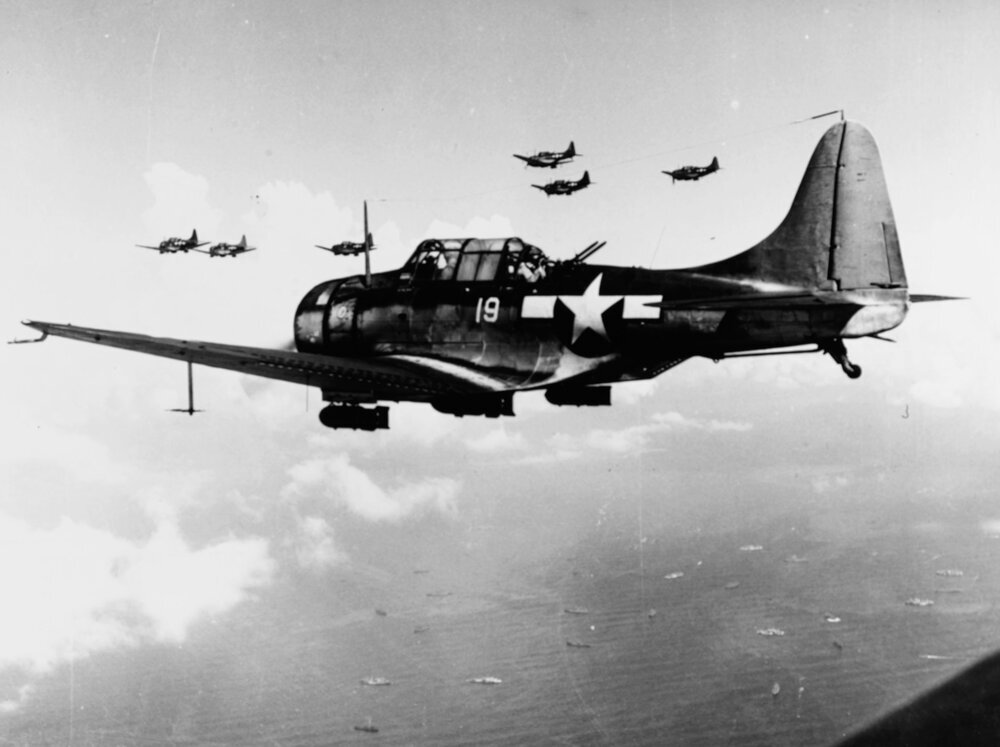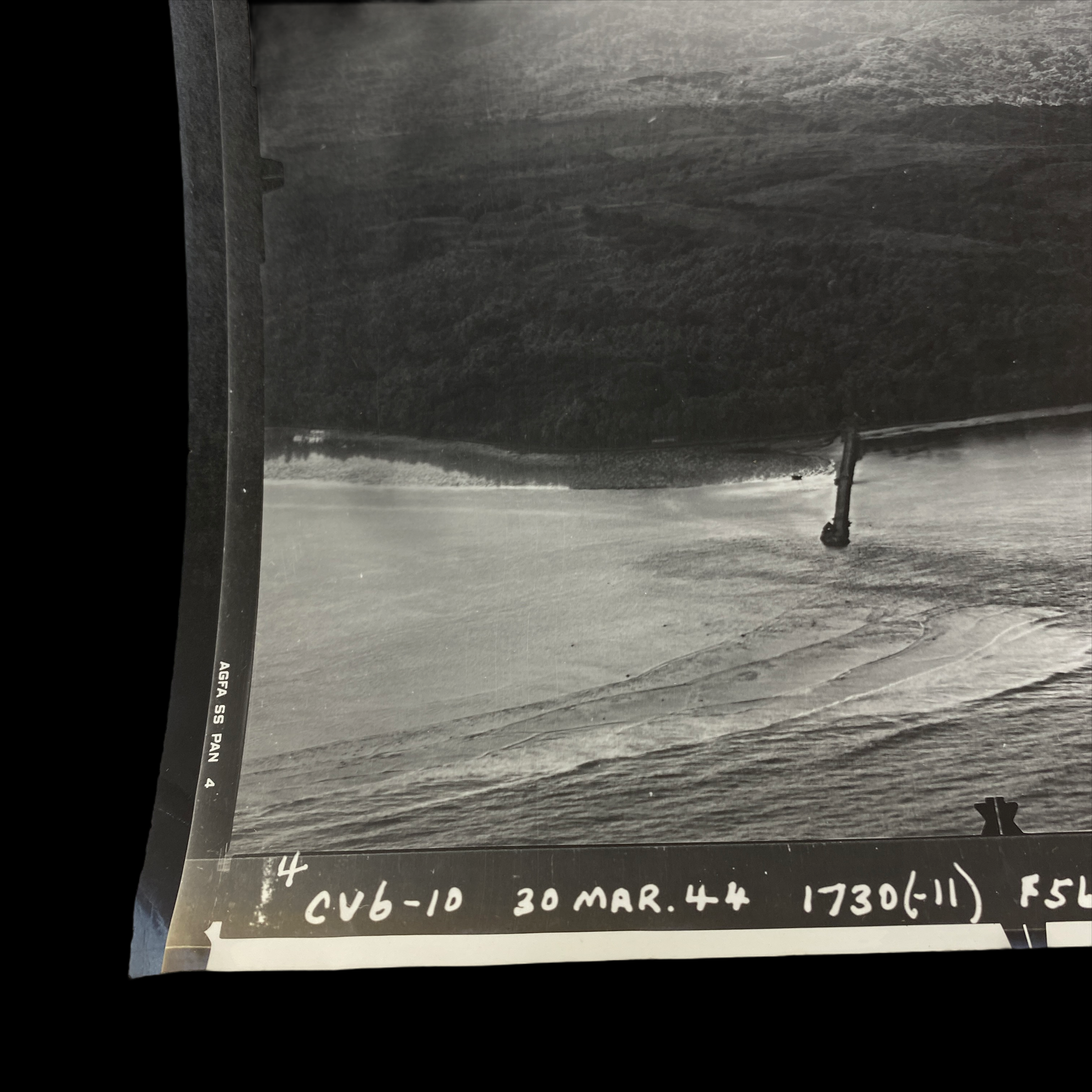3-30-1944 Dated - Assault on “Palau” - U.S.S. Enterprise CV-6 Aerial Reconnaissance Photograph (Operation Forger)












3-30-1944 Dated - Assault on “Palau” - U.S.S. Enterprise CV-6 Aerial Reconnaissance Photograph (Operation Forger)
Size: 7.5 x 7.5 inches
Letter of Authenticity included.
Dated March 30, 1944 this original ‘CONFIDENTIAL’ World War II USS Enterprise aerial reconnaissance photograph is marked “Palau” and was taken by a U.S.S. Enterprise air group pilot and is also labeled with “CV6”. Taken with a K-17 aerial camera, the K-17 camera was originally designed as an all-purpose aerial camera and was used widely throughout World War II for vertical mapping, photography, and all types of aerial reconnaissance intelligence and bomb damage assessment.
Following the pilots combat mission in the area, and their safe landing aboard the deck of the USS Enterprise this photograph was then developed aboard the carrier’s photographic development crew and was marked, used, and examined by USS Enterprise pilots (such as Lt. Moore) and other USS Enterprise high ranking commanders and officers.
Operation Forger:
The Mariana and Palau Islands campaign, also known as Operation Forager, was an offensive launched by United States forces against Imperial Japanese forces in the Mariana Islands and Palau in the Pacific Ocean between June and November 1944 during the Pacific War. The United States offensive, under the overall command of Chester Nimitz, followed the Gilbert and Marshall Islands campaign and was intended to neutralize Japanese bases in the central Pacific, support the Allied drive to retake the Philippines, and provide bases for a strategic bombing campaign against Japan.
The United States invasion force was supported by a massive combat force. The Fifth Fleet was commanded by Vice Admiral Raymond A. Spruance. Task Force 58, commanded by Vice Admiral Marc Mitscher, consisted of 15 carriers, 7 battleships, 11 cruisers, 86 destroyers and over 900 planes. The invasion force, commanded by Vice Admiral Richmond Kelly Turner, consisted of 56 attack transports, 84 landing craft and over 127,000 troops.
Beginning the offensive, United States Marine Corps and United States Army forces, with support from the United States Navy, executed landings on Saipan in June 1944. In response, the Imperial Japanese Navy's Combined Fleet sortied to attack the U.S. Navy fleet supporting the landings. In the resulting aircraft carrier Battle of the Philippine Sea (the so-called "Great Marianas Turkey Shoot") on 19–20 June, the Japanese naval forces were decisively defeated with heavy and irreplaceable losses to their carrier-borne and land-based aircraft.
U.S. forces executed landings on Saipan in June 1944 and Guam and Tinian in July 1944. After heavy fighting, Saipan was secured in July and Guam and Tinian in August 1944. The U.S. then constructed airfields on Saipan and Tinian where B-29s were based to conduct strategic bombing missions against the Japanese mainland until the end of World War II, including the nuclear attacks on Hiroshima and Nagasaki.
In the meantime, in order to secure the flank for U.S. forces preparing to attack Japanese forces in the Philippines, in September 1944, U.S. Marine and Army forces landed on the islands of Peleliu and Angaur in Palau. After heavy and intense combat on Peleliu, the island was finally secured by U.S. forces in November 1944.
Following their landings in the Mariana and Palau Islands, Allied forces continued their ultimately successful campaign against Japan by landing in the Philippines in October 1944 and the Volcano and Ryukyu Islands beginning in January 1945.
USS Enterprise and Palau:
In March, she covered the Emirau landings (one of the few easy landings of the war), then steamed 1,100 miles west of Truk to bomb the Japanese defenders of the Palau atoll, including Peleliu. In April, the Big E raided Woleai, sailed to Majuro atoll for a short rest, then headed south to cover MacArthur's landings at Hollandia, on the northwest coast of New Guinea. After the landings, she once again blasted Truk, and then returned to Majuro.
G6-1. At the cost of hard fighting and many casualties, Saipan was established as a base from which the strategic bombing of Japan could take place. In addition, it afforded protection to the northern flank of the line of advance from the Central Pacific to the Philippines, toward which the amphibious forces of the Southwest Pacific were also headed. A base in the western Carolines was needed, however, and the Palau Islands were chosen.
G6-2. To divert attention from the projected landings on Peleliu in the Palau Islands, Task Group 38.4, which included ENTERPRISE, made a raid on the Volcano and Bonin Islands. While the other carriers of the task group struck at Iwo Jima, she launched fighter sweeps against Chichi Jima and provided combat air patrol and photographic reconnaissance.
G6-3. After a brief stop at Saipan, ENTERPRISE sent fighter sweeps and photographic missions against Yap and Ulithi on 6, 7 and 8 September, followed by strikes against Malakai Harbor in the Palau Islands on 10 and 11 September.
G6-4. On 15 September, troops landed on Peleliu with planes from ENTERPRISE furnishing a part of the direct air support. She continued to provide air support until 18 September when she retired to Manus.
G6-5. The task group returned to patrol duties west of the Palaus on 27 September remaining for the next eight days ready to intercept any attempt by the Japanese Fleet to repeat the tactics used at Saipan.
G6-6. During the operations against the Palau Islands, another task group was making the first large raids on Formosa and the northern Philippines. These were designed to divert the Japanese away from the amphibious operation and to whittle down the enemy's strength in the Philippines. Opposition was so light that the decision was made to accelerate the speed of advance by landing directly in the Philippines.
Comprehensive WWII combat history of USS Enterprise (CV-6):
The Yorktown class aircraft carrier, USS Enterprise (CV-6) was commissioned at Newport News, Virginia, on May 12, 1938. Relocating to the Pacific, she was at sea during the Japanese Attack on Pearl Harbor on December 7, 1941. Three days after, she became the first U.S. Navy warship to sink a Japanese warship, submarine I-70, and later that month participated in the Wake Island expedition. In April, Enterprise covered the Dootlittle Raid on Japan and participated in the Battle of Midway that June, where her planes helped sink three Japanese aircraft carriers and a cruiser. During the Guadalcanal Campaign, she covered the landings and participated in the battles of Eastern Solomons and Santa Cruz Islands. Despite being damaged in both battles, she launched aircraft to assist the ships involved in the Naval Battle of Guadalcanal. In late 1943 and early 1944, Enterprise took part in the Gilberts and Marshall invasions and air attacks on the Japanese in the Central and Southern Pacific. In the summer of 1944, she participated in the Marianas operation and the Battle of the Philippine Sea, followed with the largest naval battle in history, the Battle of Leyte Gulf in October.In February 1945, Enterprise took part in the Iwo Jima invasion, then raids on the Japanese home islands and the Okinawa campaign in April. Due to damage received by two kamikaze attacks in April and May, she returned to the United States with the distinction of being the most decorated U.S. Navy warship during the war. Following Japan's surrender, she helped transport U.S. servicemen back to the United States. Decommissioned in February 1947, Enterprise was re-designated (CVA-6) in October 1952 and then to (CVS-6) in August 1953. Despite efforts to turn her into a museum ship, she was sold for scrapping in July 1958.